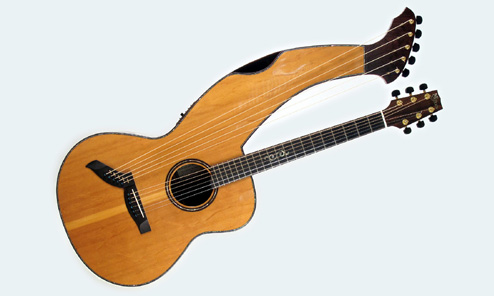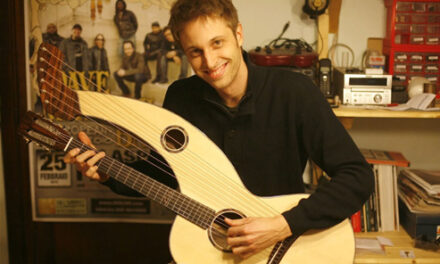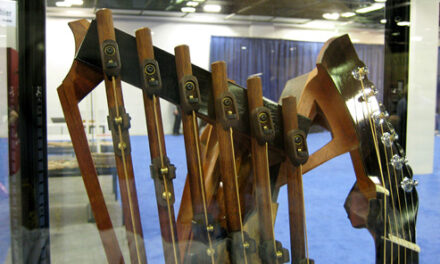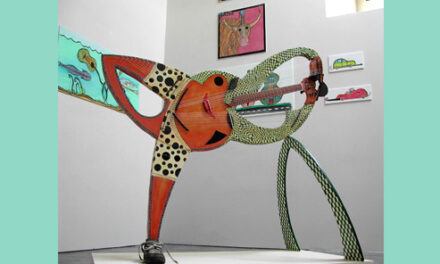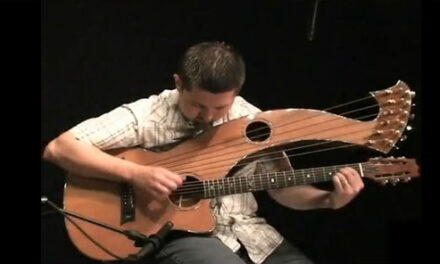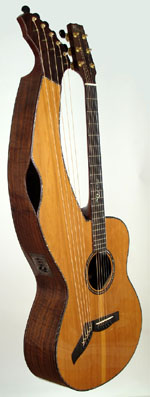
Today’s blog started out as a simple (and melancholy) story about one of the last harp guitars of the late Lance McCollum…specifically, to announce “last call” on the unique instrument I’ve had listed at Harp Guitar Music. Last call, that is, in its original configuration before it gets a new “makeover.” I’ll get to that in a minute.
Meanwhile, as I again found myself addressing the “Michael Hedges-Lance McCollum relationship” question (which I point out in my listing), I tried to get to the heart of the matter, which subsequently led me on a scavenger hunt in an attempt to put both the Hedges/McCollum story together and locate the instruments and try to put together their timeline. I’m making headway (I think I’ve resolved the “true” Hedges story) but will need the help of various owners (at least three of whom I’m still hoping to track down). I hope they’ll find and respond to these blogs in time.
So this has become a short blog series. The first part – which is of immediate concern – is the “makeover.”
The McCollum harp guitar at left that we have listed at Harp Guitar Music is one of a very few that Lance built (possibly only five?). Even if there are a couple of others secreted away out there, they are super rare; and obviously, none can ever be made again.
Frankly, if I had unlimited funds, I’d be the first to purchase the beautiful instrument that I’ve had at home here for some time. I’d do it just to preserve it as part of “tomorrow’s harp guitar history” – in other words, important history we’re making now. I’m not saying this (any of this, actually) to hype the instrument to move it. I’m saying it because the owner has now pulled it from inventory to do some modifications to it, and once the process begins (in a week? a month?), that will be that.
As you remember, Lance passed away before his time in February 2009. He left behind a legacy as one of our top independent luthiers, along with a small population of harp guitars. These have yet to be cataloged, though I’m going to start the ball rolling in the next blog. But back to the one at hand:
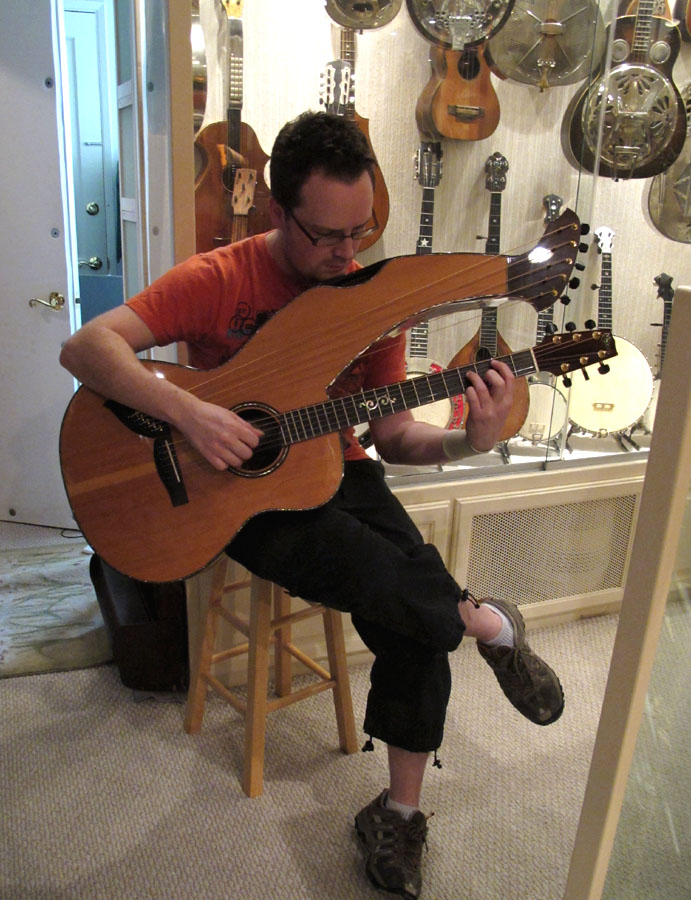
The current instrument – the only one I’ve ever actually touched (and played and heard) is one of the more unique contemporary harp guitars that I’ve come across. It’s also one of the best-sounding; it’s as rich and buttery as it gets. Antoine Dufour (at left) once played it and might have bought it on the spot if he’d the means to do so – and that despite the odd configuration. By odd, I’m talking specifically about the position and spacing of the sub-bass strings. What’s the deal?
I’m not sure. Lance advocated the split bridge for his harp guitars (vociferously so, according to Kathy Wingert). But his spacing originally wasn’t too far outside the Dyer norm, whether 5 or 6 sub-basses (as you’ll see next time). For the current 2001 instrument, the five subs are noticeably more offset and “clustered.” On my listing, I note that this looks almost like something designed specifically for Michael Hedges. Far-fetched? Well, don’t forget Lance’s own words from an old guitar forum post that I pointed out. I’ll go into this later. Meanwhile, while certainly not for Hedges, perhaps this one was intended for a client hoping to play “Because It’s There”? What else would have been the purpose of the curious 5-bass cluster? The only possible reason I can think of for Lance changing the “Dyer norm” so radically is for accommodating Hedges’ specific “sub-bass melody” technique. On the other hand, Kathy Wingert reminded me of the need to reach over the neck for sub-bass harmonics (for Hedges’ music). So you’d think Lance would have figured that out and brought them closer, rather than further out than a Dyer’s. In the end (until the original owner turns up), it remains a mystery.
It’s not all that difficult to play, but it’s not remotely normal harp guitar spacing (there’s actually no such thing as “correct” harp guitar spacing, by the way. Technically, such a thing would consist of parallel and even spacing from neck through subs, as in extended-range lutes, wouldn’t it?). Regardless of the spacing “anomaly,” it was because of the Hedges/McCollum connection that I fully expected we’d find a Hedges fanatic (or serious player of his repertoire) who would be anxious to acquire this instrument, or at least be curious about trying it out. But so far, no takers. And now, the seller, Randall Sprinkle, and I agree that this unusual string placement could be an unfortunate “deal-breaker” for prospective owners.
So Randall made the hard decision to alter it. It is now with Kathy Wingert, certainly the ideal person to take on such a project. She was Lance’s friend, has already done work on some of his instruments, and will honor his style, quality, and aesthetic, so Randall is thrilled she agreed to the project. Quite simply, the task is to increase the five sub-basses to six, with more typical spacing. The result will be a more playable instrument for most people – including Randall, who may then decide to hang onto it (he now has the Tony Karol).
Kathy hopes to do as little alteration as possible while installing a new bridge and some sort of alteration to the bass head for additional basses. While she ponders the specifics in the next couple weeks, this is your last chance to own this special instrument in its original configuration. Once she starts, that’s it. Will the final McCollum/Wingert harp guitar be “better”? I imagine yes and no (kind of “apples and oranges”). More or less “valuable”? (Does that matter?) At the end of the day, I absolutely understand and support the tricky choice Randall has made.
UPDATE: The project turned out well. Randall still owns the instrument but has it up for sale, now a black-top! See the Next Chapter: The “legend” of the Lance McCollum-Michael Hedges harp guitar, plus complete inventory of instruments!

